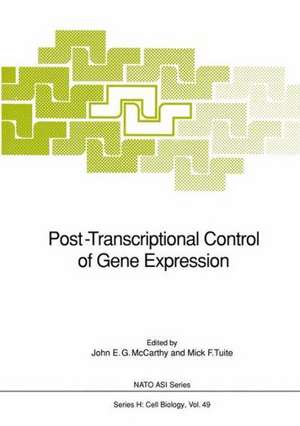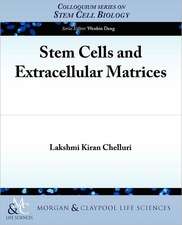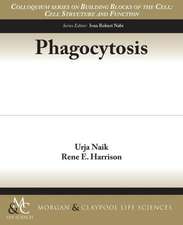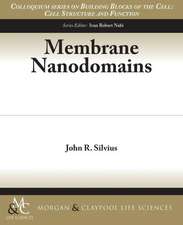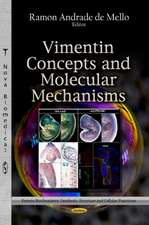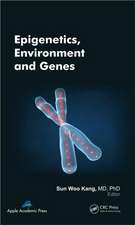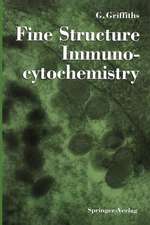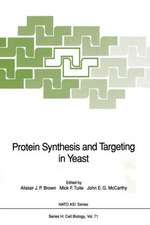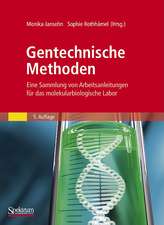Post-Transcriptional Control of Gene Expression: Nato ASI Subseries H:, cartea 49
Editat de John E. G. McCarthy, Mick F. Tuiteen Limba Engleză Paperback – 3 dec 2011
Din seria Nato ASI Subseries H:
- 18%
 Preț: 953.82 lei
Preț: 953.82 lei -
 Preț: 393.13 lei
Preț: 393.13 lei - 15%
 Preț: 643.34 lei
Preț: 643.34 lei - 15%
 Preț: 643.34 lei
Preț: 643.34 lei - 15%
 Preț: 641.03 lei
Preț: 641.03 lei - 15%
 Preț: 642.83 lei
Preț: 642.83 lei - 15%
 Preț: 642.51 lei
Preț: 642.51 lei - 5%
 Preț: 712.81 lei
Preț: 712.81 lei -
 Preț: 392.97 lei
Preț: 392.97 lei - 15%
 Preț: 651.02 lei
Preț: 651.02 lei - 15%
 Preț: 640.24 lei
Preț: 640.24 lei - 18%
 Preț: 948.61 lei
Preț: 948.61 lei - 15%
 Preț: 655.92 lei
Preț: 655.92 lei - 15%
 Preț: 655.92 lei
Preț: 655.92 lei - 15%
 Preț: 653.14 lei
Preț: 653.14 lei - 15%
 Preț: 650.19 lei
Preț: 650.19 lei - 15%
 Preț: 655.13 lei
Preț: 655.13 lei - 15%
 Preț: 652.17 lei
Preț: 652.17 lei - 15%
 Preț: 675.58 lei
Preț: 675.58 lei - 18%
 Preț: 958.07 lei
Preț: 958.07 lei - 18%
 Preț: 961.41 lei
Preț: 961.41 lei - 18%
 Preț: 970.56 lei
Preț: 970.56 lei - 5%
 Preț: 1100.30 lei
Preț: 1100.30 lei - 5%
 Preț: 376.43 lei
Preț: 376.43 lei - 15%
 Preț: 650.86 lei
Preț: 650.86 lei - 15%
 Preț: 644.63 lei
Preț: 644.63 lei - 15%
 Preț: 655.60 lei
Preț: 655.60 lei - 18%
 Preț: 963.47 lei
Preț: 963.47 lei - 15%
 Preț: 648.42 lei
Preț: 648.42 lei - 5%
 Preț: 731.43 lei
Preț: 731.43 lei - 15%
 Preț: 653.14 lei
Preț: 653.14 lei - 18%
 Preț: 960.13 lei
Preț: 960.13 lei - 18%
 Preț: 968.34 lei
Preț: 968.34 lei - 18%
 Preț: 953.97 lei
Preț: 953.97 lei - 15%
 Preț: 654.95 lei
Preț: 654.95 lei - 15%
 Preț: 652.49 lei
Preț: 652.49 lei - 15%
 Preț: 650.86 lei
Preț: 650.86 lei - 5%
 Preț: 367.64 lei
Preț: 367.64 lei - 5%
 Preț: 1104.68 lei
Preț: 1104.68 lei - 18%
 Preț: 953.20 lei
Preț: 953.20 lei - 15%
 Preț: 651.99 lei
Preț: 651.99 lei - 15%
 Preț: 647.27 lei
Preț: 647.27 lei - 15%
 Preț: 653.00 lei
Preț: 653.00 lei - 15%
 Preț: 656.25 lei
Preț: 656.25 lei - 18%
 Preț: 962.35 lei
Preț: 962.35 lei - 15%
 Preț: 644.82 lei
Preț: 644.82 lei - 15%
 Preț: 666.55 lei
Preț: 666.55 lei - 15%
 Preț: 642.68 lei
Preț: 642.68 lei - 15%
 Preț: 645.96 lei
Preț: 645.96 lei - 15%
 Preț: 651.84 lei
Preț: 651.84 lei
Preț: 663.79 lei
Preț vechi: 780.93 lei
-15% Nou
Puncte Express: 996
Preț estimativ în valută:
127.06€ • 138.06$ • 106.80£
127.06€ • 138.06$ • 106.80£
Carte tipărită la comandă
Livrare economică 21 aprilie-05 mai
Preluare comenzi: 021 569.72.76
Specificații
ISBN-13: 9783642751417
ISBN-10: 3642751415
Pagini: 680
Ilustrații: XIX, 652 p.
Dimensiuni: 170 x 242 x 36 mm
Greutate: 1.07 kg
Ediția:Softcover reprint of the original 1st ed. 1990
Editura: Springer Berlin, Heidelberg
Colecția Springer
Seria Nato ASI Subseries H:
Locul publicării:Berlin, Heidelberg, Germany
ISBN-10: 3642751415
Pagini: 680
Ilustrații: XIX, 652 p.
Dimensiuni: 170 x 242 x 36 mm
Greutate: 1.07 kg
Ediția:Softcover reprint of the original 1st ed. 1990
Editura: Springer Berlin, Heidelberg
Colecția Springer
Seria Nato ASI Subseries H:
Locul publicării:Berlin, Heidelberg, Germany
Public țintă
ResearchCuprins
mRNA Stability.- 1: Ribonucleases: diversity and regulation.- 2: Degradation of puf mRNA in Rhodobacter capsulatus and its role in the regulation of gene expression.- 3: Mutational analysis of a RNase E dependent cleavage site from a bacteriophage T4 mRNA.- 4: The role of a novel site-specific endoribonuclease in the regulated decay of E.coli mRNA — a model for growth-stage dependent mRNA stability in bacteria.- 5: Regulation of mRNA stability in yeast.- 6: Mutations involved in mRNA stability and in the length of their poly(A) tails in the yeast Saccharomvces cerevisiae.- 7: Rapid degradation of the c-fos proto-oncogene transcript.- 8: Post-transcriptional control of gene expression in chloroplasts.- 9: Differential mRNA stability: a regulatory strategy for Hsp70 synthesis.- Antisense Regulation.- 10: Post-transcriptional control of IS10 transposase expression: antisense RNA binding and other conformational changes affecting messenger RNA stability and translation.- 11: The antisense approach and early Xenoous development.- Transcriptional (Anti-)Termination.- 12: The role of boxA in transcription of ribosomal RNA operons of Escherichiacoli: changes in the Processi vi ty of RNA polymerase.- 13: Regulation of Lambda N-gene expression.- 14: Messenger RNA 3?end formation in E.coli and S. cerevisiae.- Translational Control.- 15: Culture conditions affect differently the translation of individual Escherichiacoli mRNAs.- 16: Post-transcriptional control in Escherichiacoli: the translation and degradation of mRNA.- 17: Control of translational initiation by mRNA secondary structure: a quantitative analysis.- 18: The role of ribosomal RNA in the control of gene expression.- 19: The phage f1 gene VII start site and its mutants reveal that translational coupling can conferfunction to inherently inactive initiation sites.- 20: Measurement of translation rates in vivo at individual codons and implication of these rate differences for gene expression.- 21: Regulation of gene expression by minor codons in Escherichiacoli: minor codon modulator hypothesis.- 22: A short review of scanning.- 23: Yeast mRNA structure and translational efficiency.- 24: Human fetal G?- and A?- globin mRNA and adult B-globin exhibit distinct translation efficiency and affinity for eukaryotic initiation factor 2.- 25: Effects of the 5?-leader sequence of tobacco mosaic virus RNA, or derivatives thereof, on foreign mRNA and native viral gene expression.- Translational Regulatory Circuits.- 26: Translational control of the cIII gene of bacteriophage lambda.- 27: The mom operon of bacteriophage Mu is regulated by a combination of transcriptional and translational controls.- 28: Mechanisms of ribosomal protein translational autoregulation.- 29: Translational feedback control in E.coli: the role of tRNAThr and tRNAThr-like structures in the operator of the gene for threonyl -tRNA synthetase.- 30: Translational control of the transcriptional activator GCN4 involves upstream open reading frames, a general initiation factor and a protein kinase.- 31: Translational control by arginine of yeast gene CPA1.- 32: Expression from polycistronic cauliflower mosaic virus pregenomic RNA.- 33: Polyadenylation of cauliflower mosaic virus RNA is controlled by promoter proximity.- 34: The HIV-1 Rev trans-activator is a sequence specific RNA binding protein.- 35: Control of protein synthesis by RNA regulators.- 36: Untranslated leader sequences and enhanced messenger RNA translational efficiency.- 37: Coordinate post-transcriptional regulation of ferritin and transferrin receptorexpression: the role of regulated RNA-protein interaction.- 38: Translation in yeast mitochondria: a review of general features and a case of mRNA- specific positive control.- 39: The yeast pyruvate kinase gene is regulated at multiple levels.- Biochemistry and Genetics of Translation.- 40: Initiation of protein synthesis in E.coli: the two crucial steps.- 41: The function of initiation factors in relation to mRNA-ribosome interaction and regulation of gene expression.- 42: Alternative translation and functional diversity of release factor 2 and lysyl-tRNA synthetase.- 43: Gene products that mediate translation initiation in yeast.- 44: Structure/function of mammalian initiation factors.- 45: Initiation factors involved in mRNA binding to ribosomes in Saccharomycescerevisiae.- 46: The eukaryotic mRNA cap binding protein (eIF-4E): phosphorylation and regulation of cell growth.- 47: Peptide chain initiation in animal cells: mechanism and regulation.- 48: New insights into an old problem: ternary complex (Met-tRNAf·eIF-2·GTP) formation in animal cells.- 49: Phosphorylation of initiation and elongation factors and the control of translation.- 50: Regulation of protein synthesis in mammalian systems by the guanine nucleotide exchange factor.- 51: Isolation of the lsd mutations in Saccharomycescerevisiae.- 52: Functional role and biochemical properties of yeast peptide elongation factor 3 (EF-3).- Translational Accuracy/Frameshifting.- 53: Translational Movements.- 54: Ribosomal frameshift and frame-jump sites as control points during elongation.- 55: Frameshifting in the expression of the trpR gene of Escherichiacoli.- 56: The ribosomal frame-shift signal of infectious bronchitis virus.- 57: Control of translational accuracy in yeast: the role of the Sa14 (Sup45)protein.- 58: HIV pol expression via a ribosomal frameshift.- Post-translational events.- 59: Protein modifications and mitochondrial import of yeast cytochrome c: an overview.
